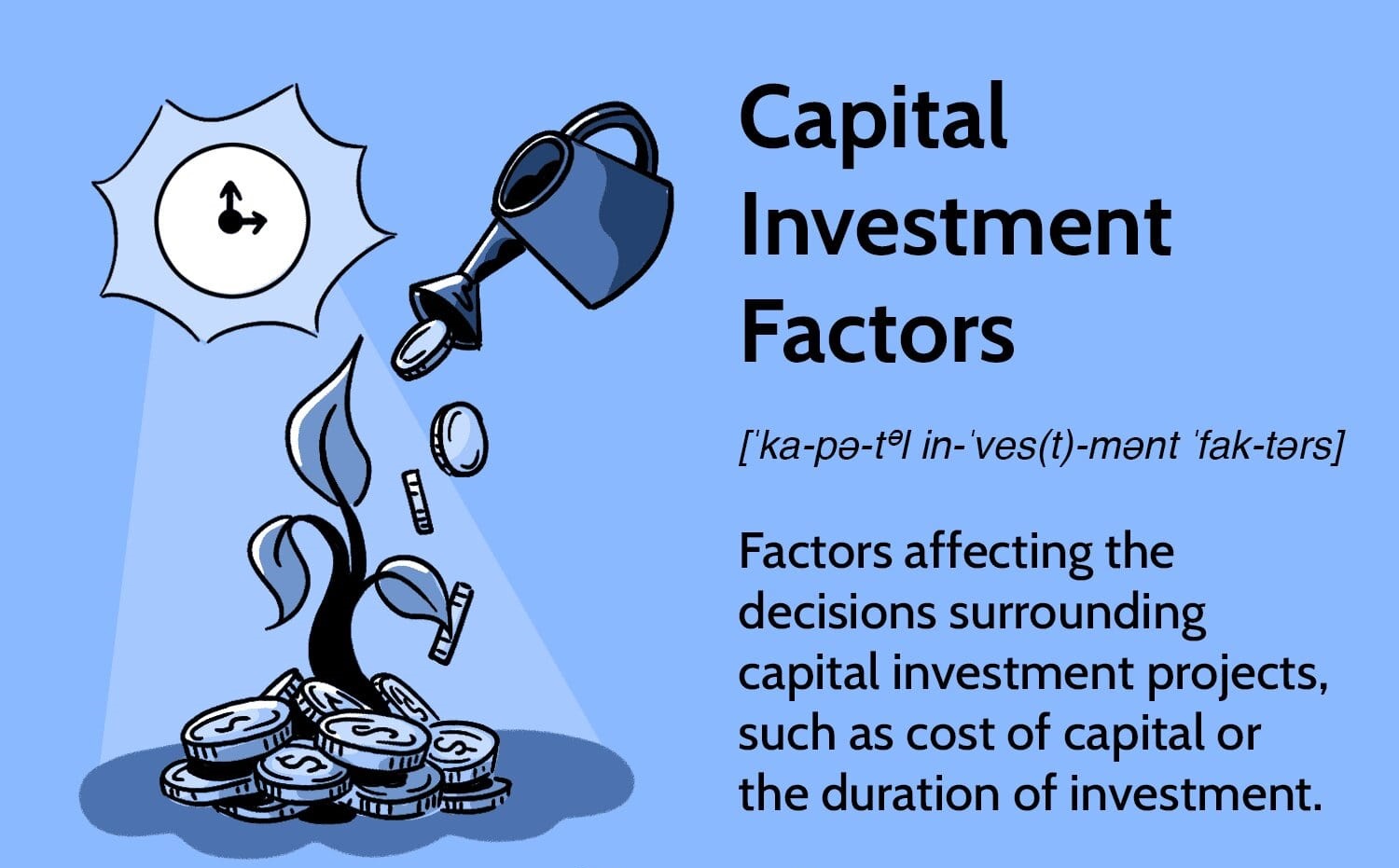Introduction
Investing is an important part of building wealth and securing our financial future. Whether you’re a seasoned investor or just starting out, evaluating investments is crucial to make informed decisions and maximize returns. The process of evaluating investments involves careful analysis and consideration of various factors to determine the suitability and potential profitability of an investment opportunity.
In this article, we will guide you through the essential steps to evaluate investments effectively. By following these steps, you can confidently assess different investment options, minimize risks, and choose investments that align with your financial goals.
Investment evaluation is not a one-size-fits-all approach. The criteria for evaluating investments may vary depending on your individual preferences and risk tolerance. However, the fundamental principles remain the same. It’s essential to understand the key factors that contribute to the evaluation process and adapt them to your specific investment needs and objectives.
Throughout this guide, we will cover important aspects such as defining your investment goals, understanding risk and return, researching investment options, analyzing financial statements, evaluating the management team, assessing market trends and industry analysis, determining the valuation of investments, considering liquidity and accessibility, understanding tax implications, and ultimately making the final decision.
By following these steps and considering each factor carefully, you can increase your chances of making successful investment decisions. Remember that investing involves both opportunities and risks, and thorough evaluation is crucial to make informed choices that align with your financial objectives.
Now, let’s delve into the step-by-step process of evaluating investments and equip ourselves with the knowledge needed to make sound investment decisions.
Step 1: Defining Your Investment Goals
Before diving into the evaluation process, it is essential to define your investment goals. Your goals will shape the type of investments you should consider, as well as the timeframe and risk tolerance you’re comfortable with.
Start by asking yourself what you want to achieve with your investments. Are you looking for long-term growth, regular income, or a combination of both? Are you saving for retirement, a major purchase, or a specific financial milestone? Understanding your objectives will guide your investment decisions and help you stay focused.
Once you have identified your goals, consider your risk tolerance. Are you comfortable with higher-risk investments that have the potential for greater returns, or do you prefer more conservative investments with lower volatility? Assessing your risk tolerance will narrow down the range of investment options that match your comfort level.
Next, establish a realistic timeframe for your goals. Are you investing for the short-term, medium-term, or long-term? Short-term goals may require more stable and liquid investments, while long-term goals may allow for more aggressive growth-oriented investments.
Another important factor to consider is your financial situation and liquidity needs. Evaluate your current income, expenses, and existing assets to determine how much you can comfortably invest. If you anticipate needing quick access to your funds in the near future, you may need to prioritize investments that offer higher liquidity.
Lastly, consider any ethical or socially responsible investment preferences you may have. If supporting companies with sustainable practices or specific social causes is important to you, incorporate these factors into your investment goals.
By clearly defining your investment goals, you establish a foundation for your investment evaluation process. This step ensures that the investments you choose align with your financial objectives and help you stay focused on achieving them. Continuously review and reassess your goals as your financial situation and priorities evolve over time.
Step 2: Understanding Risk and Return
When evaluating investments, it’s crucial to understand the relationship between risk and return. Investments with higher potential returns often come with higher risks, while investments with lower risks typically yield more modest returns.
Risk refers to the possibility of losing money or not achieving the expected return on an investment. Different investments carry varying levels of risk, depending on factors such as market volatility, economic conditions, industry stability, and the financial health of the company or asset being invested in.
Return, on the other hand, is the profit or gain an investment generates over a specific period. Evaluating the potential return of an investment is essential to assess its viability and align it with your investment goals.
To evaluate risk, consider factors such as historical performance, market conditions, and the stability of the investment. Analyzing past performance can provide insights into how an investment has weathered market fluctuations and whether it has produced consistent returns over time.
When assessing potential returns, it’s important to evaluate both the short-term and long-term prospects of the investment. Look for investments that have a track record of delivering favorable returns and consider future potential based on market trends, industry analysis, and the overall economic outlook.
Furthermore, diversification is a key strategy to manage risk and optimize returns. By spreading your investments across different asset classes, sectors, or geographic regions, you can mitigate the impact of any single investment’s performance on your overall portfolio.
Understanding your risk appetite and return expectations is crucial to finding the right balance for your portfolio. A conservative investor may prioritize investments with lower risk and stable returns, while an aggressive investor may be more willing to take on higher-risk investments for the potential of higher returns.
Keep in mind that risk and return are interconnected. Be cautious of investments that promise excessively high returns with minimal risk, as they often come with hidden pitfalls or scams. Research and due diligence are vital in assessing the risk-return tradeoff and making informed investment decisions.
By comprehending the relationship between risk and return, you can evaluate investments more effectively and align them with your risk tolerance and return objectives. Understanding the potential risks and rewards of an investment is essential for building a well-balanced and successful investment portfolio.
Step 3: Researching Investment Options
Once you have defined your investment goals and assessed your risk tolerance, the next step in evaluating investments is to research the available options. Proper research is crucial to gain a thorough understanding of the investment landscape and identify opportunities that align with your goals.
Start by exploring different investment vehicles such as stocks, bonds, mutual funds, exchange-traded funds (ETFs), real estate, or commodities. Each investment option carries unique characteristics, risks, and potential returns.
One of the best ways to research investment options is by using reputable financial resources. Consult financial websites, publications, and news outlets that provide reliable information about different asset classes and specific investments. Additionally, consider seeking advice from financial professionals or investment advisors to gain insights and expertise.
When researching individual stocks or bonds, take into account the company’s financial health, management team, competitive positioning, and growth prospects. Analyzing financial statements, including income statements, balance sheets, and cash flow statements, will provide valuable insights into the company’s profitability, liquidity, and overall performance.
For mutual funds and ETFs, evaluate factors such as the fund’s investment strategy, historical performance, expense ratio, and the expertise of the fund manager. Look for consistent returns and a well-diversified portfolio that aligns with your investment goals.
In the case of real estate investments, consider factors like location, potential rental income, property appreciation, and the overall state of the real estate market. Thoroughly review financial projections, property vacancies, and maintenance costs to make informed decisions.
Furthermore, consider the level of liquidity and accessibility each investment option provides. Some investments, like stocks and ETFs, can be easily bought and sold on the stock market, offering high liquidity. On the other hand, real estate and certain alternative investments might have more limited liquidity and longer holding periods.
Take note of any fees associated with the investment, including management fees, brokerage commissions, and transaction costs. These expenses will impact your overall returns and should be factored into your evaluation.
In addition to individual investments, also research broader market trends and industry analysis. Understanding the economic landscape, technological advancements, and regulatory changes can provide valuable insights into potential investment opportunities.
By conducting thorough research, you can gain a comprehensive understanding of different investment options, their potential returns, associated risks, and suitability for your investment objectives. Doing your due diligence will empower you to make well-informed investment decisions.
Step 4: Analyzing Financial Statements
When evaluating investments, a key step is to analyze the financial statements of the companies or entities you are considering investing in. Financial statements provide valuable insights into the financial health, performance, and profitability of an investment opportunity.
The main financial statements to review are the income statement, balance sheet, and cash flow statement. These statements provide a snapshot of the company’s financial position and performance over a specific period.
The income statement, also known as the profit and loss statement, outlines the company’s revenues, expenses, and net income or loss. It reveals the company’s ability to generate profits and indicates its financial performance over time.
The balance sheet presents the company’s assets, liabilities, and shareholders’ equity at a specific point in time. It provides a snapshot of the company’s financial health, including its liquidity, solvency, and overall financial stability.
The cash flow statement tracks the cash inflows and outflows of the company. It shows how the company generates and uses its cash, providing insights into its ability to generate cash flows and meet its financial obligations.
When analyzing financial statements, consider the following factors:
- Revenue Trends: Review the company’s revenue growth over time, as consistent and increasing revenue is often a positive sign of a healthy business.
- Profitability: Assess the company’s profitability by examining their profit margins, such as gross margin, operating margin, and net margin. Higher profit margins indicate better profitability.
- Debt Levels: Evaluate the company’s debt levels by analyzing the balance sheet. Look for a reasonable debt-to-equity ratio, as excessive debt may indicate higher financial risk.
- Liquidity: Examine the company’s liquidity position by reviewing its current assets and liabilities. A healthy liquidity position ensures the company can meet short-term obligations without difficulty.
- Cash Flow Generation: Evaluate the company’s ability to generate positive cash flows from its operating activities. A consistent positive cash flow indicates a sustainable and well-managed business.
It’s important to consider the financial statements in conjunction with other factors such as industry trends, competition, and economic conditions. This holistic approach will provide a more comprehensive picture of the investment opportunity.
If analyzing financial statements seems daunting or complex, consider seeking assistance from financial professionals or experts who can guide you through the process. They can provide valuable insights and simplify the evaluation process.
By thoroughly analyzing financial statements, you can gain a deeper understanding of the financial health, performance, and profitability of an investment opportunity. This analysis will help you make informed decisions and identify investments that align with your goals and risk tolerance.
Step 5: Evaluating the Management Team
When evaluating investments, it is crucial to assess the competence and integrity of the management team behind the investment opportunity. The management team plays a pivotal role in the success and growth of a company or investment fund.
Start by researching the background and experience of key executives and managers. Evaluate their track records, expertise, and qualifications in relation to the industry and the specific investment opportunity. Consider factors such as their education, relevant work experience, and prior successes in similar roles.
Assess the management’s strategic vision and their ability to execute on it. Look for a clear mission statement, well-defined goals, and a strategic plan for achieving those goals. Furthermore, evaluate their communication skills and transparency in providing updates to shareholders or investors.
Consider the alignment of interests between the management team and investors. Examine whether the executives have a significant stake in the company or investment fund, demonstrating their commitment to the success of the venture. The management team should be focused on creating long-term value for stakeholders rather than short-term gains.
An important aspect of evaluating management is assessing their decision-making process and risk management capabilities. Look for evidence of sound judgment, prudent risk-taking, and an ability to navigate challenging situations. Consider how the management team has responded to past crises or market downturns.
Don’t underestimate the importance of the company’s culture and values. Evaluate whether the management team promotes a culture of integrity, innovation, and accountability. A strong ethical foundation and a commitment to corporate governance are key indicators of a well-managed organization.
Consider the team’s ability to attract and retain top talent. A competent and motivated workforce is crucial for the long-term success of an investment opportunity. Look for indicators of employee satisfaction, growth opportunities, and a positive work environment.
Accessing information about the management team can be done through various sources. Review company or fund reports, press releases, and news articles. Additionally, seek out third-party analysis or opinions from industry experts to gain different perspectives on the management team’s capabilities.
Evaluating the management team is an essential step in assessing the potential success of an investment. A capable and trustworthy management team can navigate challenges, drive growth, and create value for investors. Conversely, a weak or unethical management team can pose significant risks to the investment’s performance.
By thoroughly evaluating the management team, you can gain confidence in their ability to guide the investment towards success and make informed investment decisions that align with your goals and risk tolerance.
Step 6: Assessing Market Trends and Industry Analysis
When evaluating investments, it is important to assess the current market trends and conduct a thorough analysis of the industry in which the investment operates. Understanding the broader market dynamics and industry-specific factors can provide valuable insights into the potential risks and opportunities associated with the investment.
Begin by examining the overall market conditions. Consider economic indicators, such as GDP growth, interest rates, inflation, and unemployment rates. These factors can influence consumer behavior, investor sentiment, and the overall business environment.
Next, focus on the industry in which the investment opportunity operates. Analyze the industry’s growth prospects, competition, market size, and key drivers of success. Stay updated on industry news, emerging trends, regulatory changes, and technological advancements that may impact the industry’s future.
Examine the competitive landscape to understand how the investment opportunity differentiates itself from competitors. Evaluate the market share, market positioning, and market penetration of the investment compared to its peers. Consider any potential threats or barriers to entry in the industry, as well as the investment’s ability to capitalize on market opportunities.
Identify any potential disruptions or challenges that the industry may face in the future. This could include technological advancements, changes in consumer preferences, or shifts in regulatory or legal frameworks. Assess how the investment opportunity is positioned to adapt and thrive in the face of these challenges.
Additionally, analyze the financial performance and trends of other companies within the same industry. Look for patterns in profitability, revenue growth, and market share that may indicate the overall health and potential of the industry. This analysis can also reveal any inherent risks or weaknesses in the investment opportunity.
Industry analysis requires staying up-to-date with market research reports, industry publications, and financial news sources. Utilize tools such as SWOT analysis (strengths, weaknesses, opportunities, and threats) to assess the investment opportunity in the context of the industry landscape.
It is important to note that industry analysis should not be a static process. Continuously monitor industry trends, conduct regular competitor analysis, and stay informed about market dynamics. This will allow you to adapt your investment strategy and make informed decisions based on evolving market conditions.
By assessing market trends and conducting industry analysis, you can gain a deeper understanding of the external factors that can impact your investment. This knowledge will help you evaluate the investment’s potential for success and make well-informed decisions that align with your goals and risk tolerance.
Step 7: Determining the Investment Valuation
When evaluating investments, one of the critical steps is determining the valuation of the investment opportunity. Valuation refers to the process of estimating the fair value or intrinsic worth of the investment based on various factors and methodologies.
There are several approaches to investment valuation, each with its own set of techniques and considerations. Here are some commonly used methods:
- Comparable Analysis: This method involves comparing the investment opportunity with similar companies or assets that are publicly traded or have been recently sold. By examining key financial metrics, such as price-to-earnings ratio, price-to-sales ratio, or enterprise value-to-EBITDA ratio, you can estimate the fair value of the investment relative to its peers.
- Discounted Cash Flow (DCF) Analysis: DCF analysis calculates the present value of expected future cash flows generated by the investment. By estimating future cash flows and applying a discount rate to reflect the time value of money and risk, you can determine the present value of the investment.
- Asset-Based Valuation: This method focuses on the value of the investment’s underlying assets. It involves assessing the net assets, including tangible assets like real estate or inventory, as well as intangible assets like patents or brand value. The valuation is based on the assumption that the true value lies in the underlying assets.
- Earnings Multiple: This approach values the investment based on a multiple of its earnings. By applying a specific earnings multiple, such as a price-to-earnings (P/E) ratio, you can estimate the value of the investment relative to its earnings potential.
When determining the investment valuation, it’s important to consider both quantitative and qualitative factors. Quantitative factors include financial metrics, growth projections, and industry benchmarks. Qualitative factors include the company’s competitive advantage, market position, and management’s track record.
It is essential to exercise caution when valuing investments as they are subject to market conditions and uncertainties. The valuation process should involve sensitivity analysis that considers different scenarios and risk factors that may impact the investment’s value.
Lastly, always validate your valuation assumptions and methodologies against real-world data and market trends. Consult with experts, such as financial analysts or investment professionals, to gain insights and challenges to your valuation approach.
By determining the investment valuation, you can assess the potential returns and the attractiveness of the investment opportunity. A thorough valuation analysis helps you make informed decisions, ensuring that you pay a fair price for the investment and align it with your financial objectives.
Step 8: Evaluating Liquidity and Accessibility
When evaluating investments, it is important to consider the liquidity and accessibility of the investment opportunity. Liquidity refers to how easily an investment can be converted into cash without significantly affecting its market price. Accessibility, on the other hand, refers to how readily available and feasible it is for you to participate in the investment.
Liquidity is a crucial aspect to evaluate, especially if you may need to access your funds in the near future. Investments with high liquidity can be easily bought and sold on the market without excessive transaction costs or delays. Examples of highly liquid investments include stocks traded on major exchanges or exchange-traded funds (ETFs).
Less liquid investments, such as real estate or private equity, may have longer holding periods or limited marketability. These investments can require more time and effort to convert into cash. It is essential to consider the potential impact on your financial goals and liquidity needs before committing to less liquid investments.
Additionally, consider the accessibility of the investment opportunity. Some investments may have certain eligibility criteria or minimum investment amounts that may exclude certain investors. Evaluate whether the investment aligns with your financial capacity and any specific requirements or restrictions imposed by the investment’s terms.
Furthermore, assess the logistics and practicality of participating in the investment. For example, if the investment is available only through a specific platform or brokerage account, ensure that you have access to such resources. Consider the ease of monitoring and managing the investment, as well as any ongoing reporting or administrative requirements.
It’s important to note that higher liquidity and accessibility do not necessarily indicate better investment opportunities. Investments with higher liquidity may often have lower returns or higher market volatility. Conversely, less liquid investments may offer higher potential returns but with limited access to your funds for a longer period.
Evaluate your own risk tolerance, financial goals, and time horizon to determine the appropriate level of liquidity and accessibility required for your investment portfolio. A well-balanced portfolio may include a mix of liquid and less liquid investments to align with your investment objectives and liquidity needs.
By evaluating the liquidity and accessibility of an investment opportunity, you can ensure that it aligns with your financial goals, risk tolerance, and liquidity requirements. Taking these factors into consideration will help you make informed investment decisions and build a well-rounded investment portfolio.
Step 9: Considering Tax Implications
When evaluating investments, it is crucial to consider the tax implications associated with the investment opportunity. Taxes can significantly impact your overall investment returns, so understanding the tax implications is essential for making informed decisions.
Start by assessing the tax structure and regulations in the jurisdiction where the investment operates. Different countries or regions may have varying tax laws and rates, which can affect your investment returns and potential tax liabilities.
For example, income generated from certain investments, such as dividends or interest from bonds, may be subject to income tax. Capital gains, which are profits from the sale of investments, may also be subject to capital gains tax. Understanding the applicable tax rates and rules can help you estimate the impact on your investment returns.
Consider any available tax incentives or deductions that can reduce your tax liability related to the investment. Some investments may offer tax advantages, such as tax-free municipal bonds or tax-deferred retirement accounts. Take advantage of these opportunities to optimize your after-tax returns.
Additionally, evaluate the timing of your investment transactions to minimize the tax impact. Selling investments held for a longer term can attract lower capital gains tax rates, while short-term gains may be subject to higher tax rates. Strategic tax planning can help you optimize your overall tax burden.
Take note of any tax reporting requirements associated with the investment. Familiarize yourself with the necessary forms and documentation to accurately report your investment income or capital gains. Failure to comply with tax reporting obligations can result in penalties or legal consequences.
Consult with tax professionals or financial advisors who specialize in taxation to gain insights tailored to your specific circumstances. They can provide guidance on tax-efficient investment strategies and help you navigate the complexities of tax laws.
Remember that tax laws and regulations can evolve and change over time. Stay updated on any tax law changes that may impact your investments and adjust your strategy accordingly.
By considering tax implications when evaluating investments, you can anticipate and manage the tax consequences, optimize your after-tax returns, and ensure compliance with tax regulations. Incorporating tax planning into your investment strategy is crucial for maximizing your overall investment performance.
Step 10: Making the Final Decision
After completing all the previous steps in the investment evaluation process, it’s time to make the final decision. This step involves synthesizing all the information and analysis gathered throughout the evaluation process to arrive at a well-informed investment decision.
Review your investment goals and objectives to ensure that the investment opportunity aligns with your financial aspirations and risk tolerance. Consider how the investment fits into your overall investment portfolio and diversification strategy.
Assess the findings from your research, such as the analysis of financial statements, evaluation of the management team, market trends, and industry analysis. Consider the investment valuation and how it compares to similar opportunities in the market.
Weigh the potential risks and rewards associated with the investment. It’s important to strike a balance between taking on an acceptable level of risk and the potential returns you expect to achieve.
Consider any external factors that may impact the investment, such as economic conditions, regulatory changes, or technological advancements. Evaluate how the investment can adapt to changes and continue to perform in various scenarios.
Take into account any tax implications and how they might affect your after-tax returns. Incorporating tax planning into your decision-making process can help optimize your overall investment performance.
Assess the liquidity and accessibility of the investment opportunity and consider whether it meets your investment objectives and liquidity needs. Ensure that you have the necessary resources and access to participate in the investment.
Lastly, trust your instincts and intuition. While thorough evaluation and analysis are crucial, it’s also important to consider your gut feelings and instincts. If something doesn’t feel right or align with your values, it may be a sign to reconsider or seek further information before proceeding.
Once you have considered all these factors, make the final decision based on a comprehensive evaluation and analysis. Remember that investing involves both opportunities and risks. It’s important to understand that no investment is completely risk-free, and there is always a chance of the investment not performing as expected.
Seek advice from trusted financial professionals or investment advisors if needed. Financial experts can provide valuable insights and guidance that align with your specific circumstances and investment goals.
Keep in mind that investing is a long-term journey, and the evaluation process should be ongoing. Regularly review and reassess your investment portfolio, making adjustments as needed based on changing market conditions and your evolving financial goals.
By making the final decision based on a thorough evaluation process, you can have confidence in your investment choices and increase your chances of achieving your financial objectives.
Conclusion
Evaluating investments is a critical process that involves careful analysis and consideration of various factors. By following the ten steps outlined in this guide, you can navigate through the evaluation process more effectively and make informed investment decisions.
Throughout the evaluation process, it is important to define your investment goals, understand the risk and return relationship, research investment options, analyze financial statements, evaluate the management team, assess market trends and industry analysis, determine the investment valuation, consider liquidity and accessibility, evaluate tax implications, and ultimately make the final decision.
By approaching each step systematically and thoroughly, you can gain a deeper understanding of the investment opportunities and identify investments that align with your financial goals, risk tolerance, and liquidity needs.
Remember that investing involves both opportunities and risks. No investment is guaranteed to be successful, and it is essential to continuously monitor and reassess your investments to adjust to changing market conditions and financial goals.
Consult with financial professionals or investment advisors when necessary, as their expertise can provide valuable insights and guidance tailored to your specific circumstances. Additionally, stay informed through reliable financial resources, market research reports, and industry publications.
Investing is a long-term journey, and the evaluation process should be ongoing. Regularly review and adjust your investment portfolio as needed to ensure it remains in line with your financial objectives.
By following the principles outlined in this guide, you can enhance your ability to navigate the investment landscape effectively, mitigate risks, and increase the potential for achieving your financial goals. Take your time, conduct thorough due diligence, and make informed decisions based on a comprehensive evaluation process.
Remember, the key to successful investing lies in a steadfast commitment to knowledge, research, and a disciplined approach to evaluating and selecting investments.

























